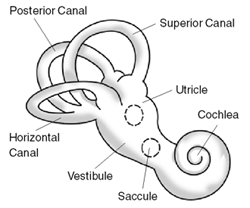Somatosensory Tinnitus Symptoms
Generally speaking, The symptoms of Pulsatile Tinnitus are fairly easy to recognise, as it is predominantly a rushing or whooshing noise in the ears that follows the sufferers own heartbeat.
Hence the rate of the noise is identical to the pulse-rate or heartbeat of the individual – hence the name ‘Pulsatile’ which literally means ‘Pulsating’ or ‘Relating to Pulsation’
To clarify a little further, there are two types of Tinnitus
Subjective T : This is a noise in the ear that only you can hear. It is more of a noise in your head, rather than an external source that others can hear also.
Objective T : This is noise that your doctor can hear when he or she does an examination. It is in fact an audible sound that can be heard during examination by others.
Pulsatile T is referred to as ‘Objective’ because in the case of an artery blockage for instance, the doctor may hear a ‘pulsing’ or ‘rushing’ noise themselves during an examination.
What Causes This Rushing Noise?

This type is also known as Somatosensory tinnitus, because it is directly caused by internal rather than external forces, such as loud noise – the most common cause of ringing sounds in the ear.
The sounds relating to pulsatile T are caused by a number of factors such as the following already mentioned in the HOMEPAGE. In this short list you will also find some suggestions for possible solutions to this particular form of Tinnitus.
- Middle Ear Effusion: Also called Otitis Media With Effusion. This occurs when the middle ear fills with fluid due to an inner ear infection, possibly caused by opportunistic bacteria sometimes picked up at the local swimming baths; and is a common cause of pulsatile tinnitus. This is usually corrected by a course of anti-biotics, but in some rarer cases may require light surgery if the Eustachian tube has become blocked or damaged.
- Glomus Tumor: This is a tumor that lodges beside or in the ear canal, putting pressure on the blood vessels surrounding the ear. This may be removed by minor surgery in normal conditions.
- Benign Intracranial Hypertension: This is quite common amongst young overweight girls and women, and is due to increased pressure from liquid that surrounds the brain. Apart from pulsatile tinnitus symptoms, this can also produce headaches, loss of hearing altogether as well as some visual impairment and dizziness. In the severely overweight, this condition can see great improvement by a good diet or life change, resulting in weight loss and general improved physical condition.
- Twisted Artery: Another common cause of rushing sound in the ears is a twisted artery in the neck leading to a restricted blood flow. This leads to a build-up of pressure as the blood pushes a path through the vein. This can also be caused by a clogged artery that may need minor surgery to put right.
- High Blood Pressure: The symptoms of T are almost always exacerbated by high blood pressure. High blood pressure itself can be brought on by any number of factors including stress, hard physical work, medication or even certain foodstuffs. The general cure for this is to investigate the cause of the high blood pressure to begin with, and then to take steps to reduce the blood pressure and thus stop the symptoms of T.
- Earwax: A build-up of earwax in the eardrum can lead to ear-ache and infection problems. If the wax is allowed to build up and harden then it may have to be softened with an infusion of warm water mixed with a little salt, or some other suitable flushing agent.
- Age: Yes unfortunately age does indeed come with its own problems! With age can come hearing loss which can also lead to T problems. The medical term for this kind of tinnitus is called presbycusis. Although not directly related to pulsatile T it is worth noting – particularly if you are over 60.
Weird Sound In Ear Like Wind
Sometimes this rushing sound is replaced by a weird sound in the ear like rushing wind. The good news is that this form of T is generally not too serious, and can in fact last for only minutes at a time, and during certain ‘episodes’ in your life.
For instance it can be caused by sudden exertion when you have not had time to ‘warm up’ before launching into some serious activity. Usually a sit down until it passes will suffice, and you can get on with what your doing – albeit with some caution!
However – and I cannot re-iterate this enough – if it is a problem that will not go away, or indeed if it occurs without an obvious external cause, then a proper medical examination may be in order – go and see the doctor without further delay. If nothing else, it may well put your mind at ease.
Otherwise sometimes even a change of lifestyle, diet, or tinnitus therapy such as the Tinnitus Retraining Therapy listed below, can be enough to keep Pulsatile and other tinnitus conditions at bay.
CHECK OUT TINNITUS RETRAINING THERAPY HERE
Next: Hyperacusis
